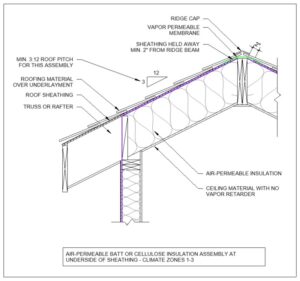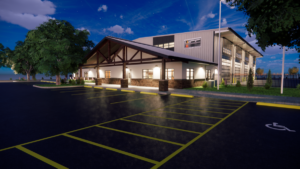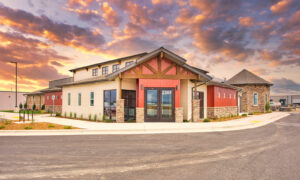With energy costs constantly on the rise and sustainability issues being at the forefront of every design interview we have, there is no better time to talk about one of the easiest ways to save energy and reduce our carbon emmissions: Insulation. The specific type of construction that this post addresses is cavity wall and roof construction. Like in most homes and a lot of commercial and multifamily buildings, these are walls that are built with wood or metal studs and roofs built with rafters or trusses. In many circumstances, it may be too late if your building is already built, but for those of you planning for new construction, or a remodel/addition, now is the time to be thinking about these things.
Not only are there some great new technologies available for insulation, but this is one area where you probably get the most bang for your buck when it comes to thermal performance. This is primarily because, it’s all relatively cheap (note: relatively is a relative term). And remember that a good thermal envelope with a sound insulation package helps save energy in both heating and cooling seasons. Below is a synapsis of some conventional methods and what to expect with each…
Fiberglass ($) – Everyone remembers the Pink Panther peddling this soft pink stuff by the roll – just remember not to let it touch your skin or you will itch into next week. The cotton-candy like fibers are actually tiny fibers of glass (thus fiberglass) and they insulate by trapping the air in the wall. You can get up to about R-3.5 per inch of this material (and up to R-5 with high density batts), which isn’t too bad. The only problem is that fiberglass doesn’t close all the gaps and there are a lot of areas that become weak in your thermal envelope (electrical receptacles, doors and windows, etc.). If these areas are not carefully installed, you will have problems. Also, if the material gets wet, all bets are off. Compressed or wet fiberglass is considered essentially useless as an insulation and would need to be replaced.
Cellulose ($) – In some markets, Cellulose is actually cheaper than fiberglass. This material is basically like lint made up of shredded material – everything from newspaper to denim. It is also treated with insecticide and fireproofing. They blow this into the stud cavities or attic spaces and because the material has no internal threading like fiberglass, you can fill every nook and cranny with it. Because the insulation method is also by trapping air, the r-value per inch is very similar to fiberglass. The installation is much better though and performance improves considerably. There has been some concern about cellulose settling over time, leaving gaps, but with a wet installation that includes a binder (a glue of sorts), these issues have largely been addressed.
Rigid insulation ($$) – These are the stiff ultra-light styrofoam panels that you have seen occassionally blowing around jobsites. There are a lot of different types of materials that comprise the family of rigid insulations, and may warrant their own blog. For the purpose of this post, you can get r-4 per inch using EPS or Phenolic panels and up to R-7.5 for the Polyurethane rigid panels. The materials in these panels are reasonably inexpensive, but the labor to install becomes very difficult to justify for cavity wall or roof insulation. More often than not, these materials are used in EIFS stucco systems, or really any siding system where the insulation can be installed continuously outside the structure without interruption, and also in roof deck applications where the entire roof is clad in the continuous rigid panel above the structural deck. There are other construction methods which are taking advantage of the high r-value of rigid insulation: SIPs construction where the panels run continuous, sandwiched between OSB panels and ICF form construction, which utilizes these materials for foundation construction with excellent results. Point being, for cavity insulation, the r-value is high, but so is the labor cost and you still have the same gap problems you get with fiberglass.
Spray-in foam ($$$) – This method, while the most expensive, is by far the tightest solution for a cavity wall construction. The material is Polyisocyanurate and can have an R-value averaging about 7 per inch. They spray it into the cavities and it expands to seal every nook and cranny. It hardens into a plastic material that is not only stable (important if you want your building to perform 20 years from now as well as it does today), but is also essentially inert and won’t react with other building materials. Like other rigid solutions, It can get wet and it won’t lose r-value. Installation typically requires a trained crew, but once installed, the building will perform similar to a SIPs built home. We are hoping that over time, this installation becomes more commonplace so that prices can even out.
Analysis: How should you sort out this information and decide on the best choice for your project? Often, thickness of wall or roof system and desired net R-value dictate this. Or perhaps your construction method may decide for you (SIPs, ICF, EIFS, etc..). Regardless, you can expect to pay on average between $.80 and $.90 a square foot for R-19 insulation using Fiberglass or Cellulose, installed with the Rigid being more, depending on application and spray-in being double and sometimes triple that depending on availability of installers. With that being said, you may be paying about $5,000 for fiberglass or cellulose for a modest 2,500 sq.ft. home and another $5,000 or more for spray-in foam. If your construction budget is particularly price sensitive, cellulose may be your best choice here. If, however, your initial cost is less important than your life-cycle cost and how well your building performs over time (and how it uses energy to heat and cool), then the spray-in technique may be better suited to your project. We cover these issues from the programming phase in the design process all the way through development of the Construction Documents and can help advise you on the best choice for your project. This way, you have all of the information you need to make the right decision to… insulate your investment.










